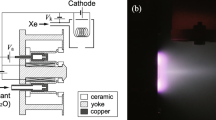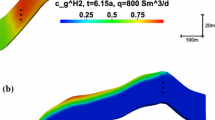The results of experimental studies of heat transfer during boiling of sodium-potassium alloy in the presence of natural convection in model FA of a fast reactor with seven fuel-rod simulators are reported. The method of investigation is described. Data are obtained for three regimes of boiling of the liquid metal in FA: stable (nucleate), unstable (slug), and secondary stable (disperse-annular). The unstable boiling regime developed in two directions depending on the state of the surface of the simulators: in the presence of manufacturing roughness – in the direction of damping of pulsations, stabilization of boiling, and subsequent stable heat removal in the presence of a fi lm of liquid on the surface of the simulators (disperse-annular regime of boiling) or in the presence of small roughness – in the direction of increasing amplitude of flow and temperature pulsations. Data on an emergency regime with pressure reduction in the circulation loop, initial superheating upon boiling-up of the liquid metal, heat transfer, and a cartogram of the two-phase flow regimes of liquid metals are presented. The boundaries of the regimes are described by analytical expressions.
Similar content being viewed by others
References
Thermophysical Stand Base of Nuclear Power in Russia and Kazakhstan, Sarov, RFYaTs–VNIIEF (2016).
Y. Kikuchi, T. Takahushi, and K. Haga, “Incipient boiling of sodium in a single-pin annular channel,” J. Nucl. Sci. Technol., 11, 172–386 (1974).
N. M. Galin and P. L. Kirillov, Heat and Mass Transfer (in nuclear power), Energoatomizdat, Moscow (1987).
V. M. Borishanskii, S. S. Kutateladze, I. I. Novikov, and O. S. Fedynskii, Liquid-Metal Coolants, Atomizdat, Moscow (1976), 3rd ed.
Yu. A. Zeigarnik and V. D. Litvinov, Boiling of Alkali Metals in Channels, Nauka, Moscow (1983).
K Yamaguchi, H. Nakamura, and K. Haga, “Boiling and dry-out condition in disturbed cluster geometry and their application to the LMFBR local fault assessment,” J. Nucl. Sci. Eng., 3, 464–474 (1984).
A. Bennett, Flow Visualization Studies of Boiling Water at High Pressures, AERE-R4874 (1965).
Yu. M. Kuznetsov, Heat Transfer in the Problem of the Safety of Nuclear Reactors, Energoatomizdat, Moscow (1989).
Author information
Authors and Affiliations
Corresponding author
Additional information
Translated from Atomnaya Énergiya, Vol. 126, No. 2, pp. 69–76, February, 2019.
Rights and permissions
About this article
Cite this article
Sorokin, A.P., Kuzina, Y.A. & Ivanov, E.F. Characteristics of Heat Transfer During Boiling of Liquid Metal in the Fuel Assemblies of Fast Reactors in Emergency Regimes. At Energy 126, 73–82 (2019). https://doi.org/10.1007/s10512-019-00518-0
Received:
Published:
Issue Date:
DOI: https://doi.org/10.1007/s10512-019-00518-0




